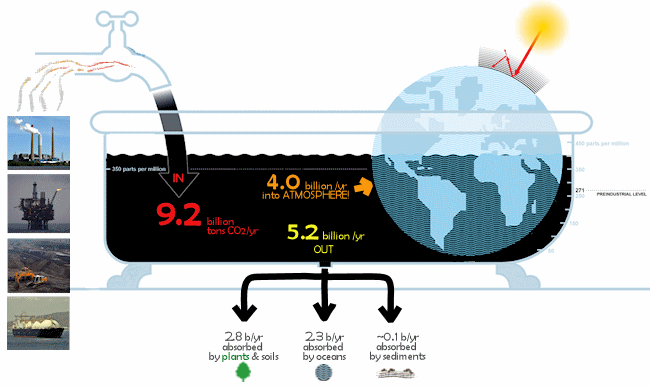Creating Equitable Workplaces
Background
Water has an often understated power. We know that it sustains us, grows our crops, carries our goods, and tempers our climate. It is also one of the most destructive forces the world has ever known, capable of crashing over or eroding away anything in its path.
It is easy to see water only for its effects on the thing we’re paying attention to: say, whether the rain will ruin our weekend plans. But we can only understand water’s impact on us by approaching it systematically, in all its forms.
It is no accident that water is the most-used metaphor in systems theory. The bathtub model, in which we measure not just how much water there is in the tub, but how different inputs and outputs affect the volume, helps us to determine how to avoid the tub running dry—or overflowing. For example, this graphic depicts the climate crisis, showing that our inputs are pushing us to an overflow, that being the brink of disaster.

Systems theory is also a useful frame for diversity, equity and inclusion. If we think of what it means for a workplace to truly value, accommodate and reward everyone equitably, it’s easy to focus on one kind of input or output: number of employees by gender, race or ability, or productivity levels. But flows are uneven, and the causes can be hard to measure. What we need in order to get a clearer picture of the equity in a system is, essentially, to ask the water how it’s flowing.
Introduction
How do we measure an equitable workplace? Since the advent of the first-wave “diversity” and second-wave “diversity and inclusion” frames for integrating the workforce, many policymakers, academics and executives have proposed ways forward, but few with measurable success.
Experiments in workplace diversity have frequently devolved into stereotypes of marginalized identities, attempts to force-fit marginalized people into the structures already created by identities in power, or abstracted into sociometrics in an attempt to avoid actual discussions of exclusion and oppression woven into the model of work. And yet, research shows that organizations that do express principles of inclusion and equity in the workplace are more effective, and more profitable.
What if we’re measuring the wrong thing? Instead of basing the success of an organization on its work rate and productivity level, and therefore the return on investment of diversity and inclusion work, what if we took an empirical approach focused on the approaches of those successful organizations, and saw what happened when some popular approaches were applied in a controlled environment?
The Experiment
For the purposes of this project, I intend to work with a product team at a large software company. The experiment has two phases:
- In collaboration with my advisors, I will consult experts in diversity, equity and inclusion roles at similar organizations, ask them about the methodologies I have uncovered, and their experiences with the efficacy of each.
- Based on this work, I will construct a working plan for implementing this in a team of approximately 100 employees, representing common roles and levels in software development. I will embed myself with the team, leading a workshop on the changes to be undertaken in the team over a three-month period. I will conduct entry and exit interviews, as well as a program of journaling with employees who have opted in. Employees will be asked to provide weekly feedback on their experiences.
Based on this data, I will report on employee perspectives on their own shared control of the overall project. On issues where they or people who share identities with are concerned, were those issues prioritized and addressed? Did people from throughout the organization have chances to advocate for change at all levels, not just in the product being developed but also the system that builds it? And how did these techniques affect the product, and the working relationships of the team?

